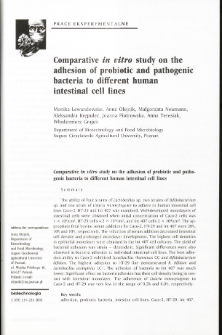- Wyszukaj w całym Repozytorium
- Piśmiennictwo i mapy
- Archeologia
- Baza Młynów
- Nauki przyrodnicze
Wyszukiwanie zaawansowane
Wyszukiwanie zaawansowane
Wyszukiwanie zaawansowane
Wyszukiwanie zaawansowane
Wyszukiwanie zaawansowane

Obiekt
Tytuł: Comparative in vitro study on the adhesion of probiotic and pathogenic bacteria to different human intestinal cell lines
Twórca:
Lewandowska, Monika ; Olejnik, Anna ; Neumann, Małgorzata ; Krępulec, Aleksandra ; Piotrowska, Joanna ; Teresiak, Anna ; Grajek, Włodzimierz
Data wydania/powstania:
Typ zasobu:
Inny tytuł:
Wydawca:
Committee on Biotechnology PAS ; Institute of Bioorganic Chemistry PAS
Abstrakt:
The ability of four strains of Lactobacillus sp. two strains of Bifidobacterium sp. and one strain of Listeria monocytogenes to adhere to human intestinal cell lines Caco-2, HT-29 and Int 407 was examined. Well-developed monolayers of intestinal cells were obtained when initial concentration of Caco-2 cells was 1 X lO'^/cm^, HT-29 cells 4.2 x lO'^/cm^, and Int 407 cells 2 x lO'^/cm^. The appropriate fetal bovine serum additions for Caco-2, HT-29 and Int 407 were 20%, 10% and 10%, respectively. The reduction of serum addition decreased intestinal cell density and prolonged monolayer development. The highest cell densities in epithelial monolayer were obtained in the Int 407 cell cultures. The yield of bacterial adhesion was strain - dependent. Significant differences were also observed in bacteria adhesion to individual intestinal cell lines. The best adhesion ability to Caco-2 exhibited Lactobacillus rhamnosus GG and Bifidobacterium bifidum. The highest adhesion to HT-29 line demonstrated B. bifidum and Lactobacillus acidophilus LCl. The adhesion of bacteria to Int 407 was much lower. Significant effect on bacteria adhesion has their cell density being in contact with intestinal monolayer. The adherence of Listeria monocytogenes to Caco-2 and HT-29 was very low in the range of 0.2% and 6.0%, respectively.
Czasopismo/Seria/cykl:
Biotechnologia, vol.69, 2 (2005)-.
Tom:
Zeszyt:
Strona pocz.:
Strona końc.:
Szczegółowy typ zasobu:
Format:
Identyfikator zasobu:
0860-7796 ; oai:rcin.org.pl:111552 ; IChB B-65
Źródło:
Library of Institute of Bioorganic Chemistry PAS
Język:
Język streszczenia:
Zakres czasowy:
Prawa:
Creative Commons Attribution BY-SA 4.0 license
Zasady wykorzystania:
Digitalizacja:
Institute of Bioorganic Chemistry of the Polish Academy of Science
Lokalizacja oryginału:
Institute of Bioorganic Chemistry of the Polish Academy of Science
Dofinansowane ze środków:
Dostęp:
Kolekcje, do których przypisany jest obiekt:
- Repozytorium Cyfrowe Instytutów Naukowych > Kolekcje Partnerów > Instytut Chemii Bioorganicznej PAN > Artykuły
- Repozytorium Cyfrowe Instytutów Naukowych > Piśmiennictwo > Czasopisma/Artykuły
Data ostatniej modyfikacji:
2 paź 2020
Data dodania obiektu:
31 sty 2020
Liczba pobrań / odtworzeń:
218
Wszystkie dostępne wersje tego obiektu:
https://rcin.org.pl./publication/139601
Wyświetl opis w formacie RDF:
Wyświetl opis w formacie RDFa:
Wyświetl opis w formacie OAI-PMH:
| Nazwa wydania | Data |
|---|---|
| Comparative in vitro study on the adhesion of probiotic and pathogenic bacteria to different human intestinal cell lines | 2 paź 2020 |
Obiekty Podobne
Grajek, Włodzimierz Olejnik, Anna Staniaszek, Katarzyna
Borkowska, Bożenna
Ziółkowski, Piotr Babula- Skowrońska, Danuta Kaczmarek, Małgorzata Cieśla, Agata Sadowski, Jan
Grajek, Włodzimierz
Grajek, Włodzimierz

 INSTYTUT ARCHEOLOGII I ETNOLOGII POLSKIEJ AKADEMII NAUK
INSTYTUT ARCHEOLOGII I ETNOLOGII POLSKIEJ AKADEMII NAUK
 INSTYTUT BADAŃ LITERACKICH POLSKIEJ AKADEMII NAUK
INSTYTUT BADAŃ LITERACKICH POLSKIEJ AKADEMII NAUK
 INSTYTUT BADAWCZY LEŚNICTWA
INSTYTUT BADAWCZY LEŚNICTWA
 INSTYTUT BIOLOGII DOŚWIADCZALNEJ IM. MARCELEGO NENCKIEGO POLSKIEJ AKADEMII NAUK
INSTYTUT BIOLOGII DOŚWIADCZALNEJ IM. MARCELEGO NENCKIEGO POLSKIEJ AKADEMII NAUK
 INSTYTUT BIOLOGII SSAKÓW POLSKIEJ AKADEMII NAUK
INSTYTUT BIOLOGII SSAKÓW POLSKIEJ AKADEMII NAUK
 INSTYTUT CHEMII FIZYCZNEJ PAN
INSTYTUT CHEMII FIZYCZNEJ PAN
 INSTYTUT CHEMII ORGANICZNEJ PAN
INSTYTUT CHEMII ORGANICZNEJ PAN
 INSTYTUT FILOZOFII I SOCJOLOGII PAN
INSTYTUT FILOZOFII I SOCJOLOGII PAN
 INSTYTUT GEOGRAFII I PRZESTRZENNEGO ZAGOSPODAROWANIA PAN
INSTYTUT GEOGRAFII I PRZESTRZENNEGO ZAGOSPODAROWANIA PAN
 INSTYTUT HISTORII im. TADEUSZA MANTEUFFLA POLSKIEJ AKADEMII NAUK
INSTYTUT HISTORII im. TADEUSZA MANTEUFFLA POLSKIEJ AKADEMII NAUK
 INSTYTUT JĘZYKA POLSKIEGO POLSKIEJ AKADEMII NAUK
INSTYTUT JĘZYKA POLSKIEGO POLSKIEJ AKADEMII NAUK
 INSTYTUT MATEMATYCZNY PAN
INSTYTUT MATEMATYCZNY PAN
 INSTYTUT MEDYCYNY DOŚWIADCZALNEJ I KLINICZNEJ IM.MIROSŁAWA MOSSAKOWSKIEGO POLSKIEJ AKADEMII NAUK
INSTYTUT MEDYCYNY DOŚWIADCZALNEJ I KLINICZNEJ IM.MIROSŁAWA MOSSAKOWSKIEGO POLSKIEJ AKADEMII NAUK
 INSTYTUT PODSTAWOWYCH PROBLEMÓW TECHNIKI PAN
INSTYTUT PODSTAWOWYCH PROBLEMÓW TECHNIKI PAN
 INSTYTUT SLAWISTYKI PAN
INSTYTUT SLAWISTYKI PAN
 SIEĆ BADAWCZA ŁUKASIEWICZ - INSTYTUT TECHNOLOGII MATERIAŁÓW ELEKTRONICZNYCH
SIEĆ BADAWCZA ŁUKASIEWICZ - INSTYTUT TECHNOLOGII MATERIAŁÓW ELEKTRONICZNYCH
 MUZEUM I INSTYTUT ZOOLOGII POLSKIEJ AKADEMII NAUK
MUZEUM I INSTYTUT ZOOLOGII POLSKIEJ AKADEMII NAUK
 INSTYTUT BADAŃ SYSTEMOWYCH PAN
INSTYTUT BADAŃ SYSTEMOWYCH PAN
 INSTYTUT BOTANIKI IM. WŁADYSŁAWA SZAFERA POLSKIEJ AKADEMII NAUK
INSTYTUT BOTANIKI IM. WŁADYSŁAWA SZAFERA POLSKIEJ AKADEMII NAUK




































